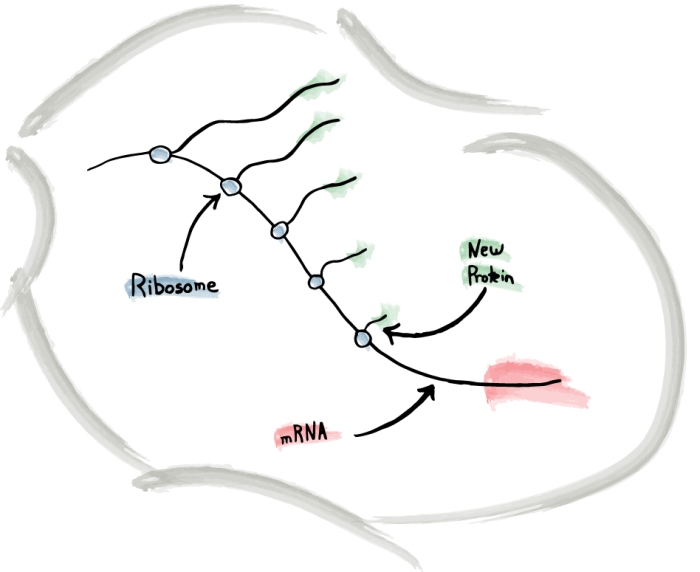In 1956, Francis Crick set forth the Central Dogma of Molecular Biology: our genomic material, DNA, is used to produce mRNA, the mobile instructions for protein synthesis. In the years since Crick’s pronouncement, our knowledge of the dogma has only grown more intimate: we’ve discovered complex networks of gene regulation, DNA sequences that do not make proteins, and the ability to visualize DNA replication and the creation of mRNA. However, translation, the process by which cells create proteins using an mRNA template, remained difficult to see until recently, when several groups published methods for viewing new proteins as they are born
One such researcher, Tim Stasevich at Colorado State University, designed a way to visualize translation using existing technology. Dr. Stasevich thinks the ability to peer upon the creation of proteins is a big step forward for molecular biology. Not only does his technique provide important information about the process of translation, it may prove important for medical research on diseases involving translation, including viral infection, Huntington’s disease, and Alzheimer’s disease.
To explain how one visualizes the creation of proteins, Dr. Stasevich describes mRNA as an escalator. The passengers on this escalator are ribosomes, which are the machines that produce proteins. As the ribosomes ride along the mRNA, they manufacture new proteins, which gradually elongate as the ribosome travels further along the escalator. Crucially, just like an actual escalator, many ribosomes ride an mRNA at once, creating multiple copies of a protein simultaneously. Dr. Stasevich took advantage of this simultaneous production in his technique, which he calls Nascent Chain Tracking, or NCT. To visualize the escalator and its occupants, Dr. Stasevich utilized fluorescent proteins, labeling the mRNA red while labeling the newly formed proteins green. The color coordination allowed Dr. Stasevich’s group to watch ribosomes enter and exit the escalator, providing information about where protein creation happens and how fast the escalator moves.

Dr. Stasevich’s group applied the NCT technique to several common cellular proteins. They found that these proteins were created once about every thirty seconds in random locations around the cell. They also tracked new proteins in 3D space, and in the process learned that the mRNA dances around quite a bit during translation. Finally, the group calculated the average speed of protein synthesis to be 10 amino acids per second, which translates to 30 steps on the mRNA escalator.
Though their results may only hold interest for lab scientists at the moment, Dr. Stasevich envisions many applications for NCT in research on human diseases. Viral infection, the recent macabre star of the news because of the Zika and Ebola viruses, is fundamentally a problem of protein production. The first step in viral infection takes place when the invading virus hijacks the host’s protein translation system, and NCT could prove useful in understanding this process. Additionally, neurological diseases like Huntington’s and Alzheimer’s involve problems with translation. NCT could provide finer detail about the mechanisms of these diseases.
NCT is an elegant technique, with the potential to unlock the secrets of the most difficult diseases science faces. Just as impressive is the fact that NCT is cobbled together out of several existing technologies. Sometimes, big discoveries have mundane origins, especially in the hands of a tech hacker like Dr. Stasevich. After all, “You can do good science, with a much cheaper bill, if you hack things. That’s what I love about science, is that it gives you the opportunity to just be very creative… to develop new technology.”